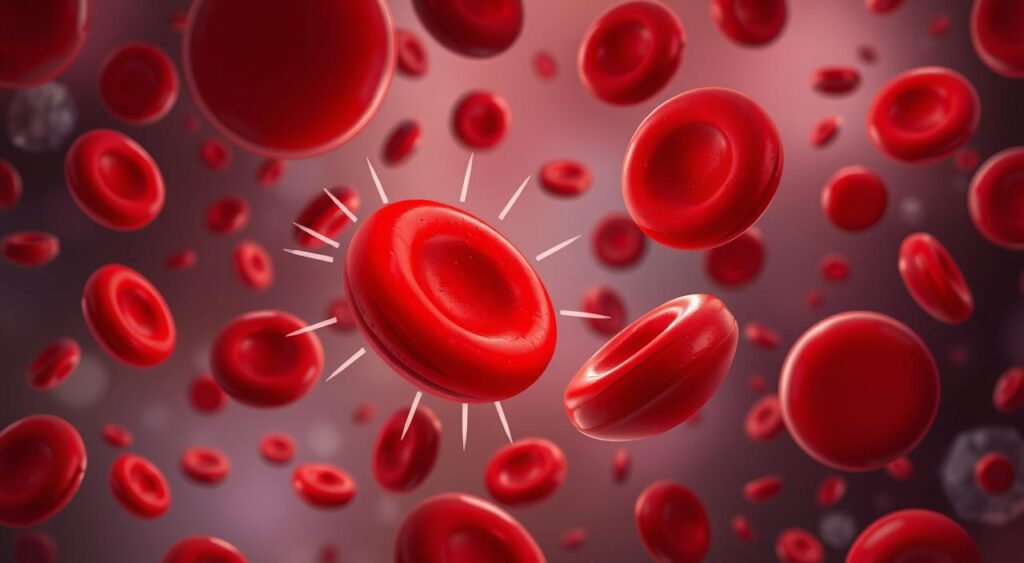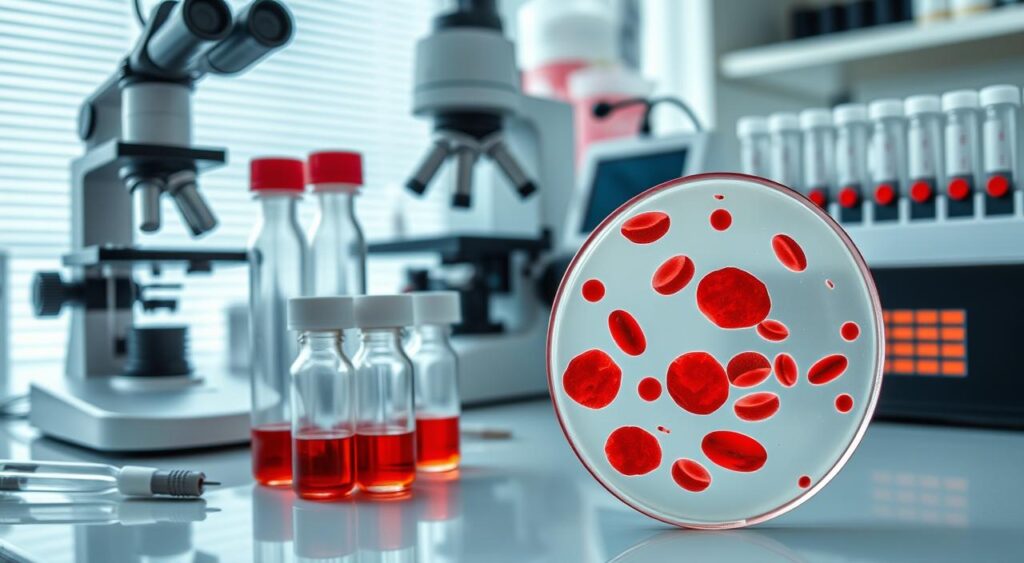Sickle cell anaemia is the most common type. It’s a genetic disorder that affects how red blood cells carry oxygen. Knowing about sickle cell anaemia helps manage the condition and improve life quality.

Sickle cell anaemia and sickle cell disease are often confused. But they both deal with haemoglobin production issues. This article will explore causes, symptoms, and treatments for sickle cell anaemia. It aims to help patients, caregivers, and healthcare professionals.
Key Takeaways
- Understanding the genetic basis of sickle cell disease is essential for managing the condition.
- Sickle cell anaemia is the most common form of sickle cell disease.
- Early diagnosis and treatment can significantly improve the quality of life for those affected.
- Sickle cell anaemia and sickle cell disease require a comprehensive treatment approach.
- Lifestyle modifications and pain management strategies can help alleviate symptoms.
- Staying informed about sickle cell anaemia and sickle cell disease is crucial for making informed decisions about care and treatment.
Understanding Sickle Cell Anaemia
Sickle cell anaemia is a genetic disorder that affects how red blood cells carry oxygen. It happens when haemoglobin, a protein in red blood cells, is abnormal. This leads to red blood cells becoming misshapen and breaking down. People with sickle cell trait carry the disease but might not show symptoms.
Being a sickle cell trait carrier means there’s a higher chance of passing the disease to children. It’s crucial for those with sickle cell history to get genetic testing. This helps them plan their family and make health decisions.
There are different types of sickle cell disease, including:
- Sickle cell anaemia (HbSS)
- Sickle cell haemoglobin C disease (HbSC)
- Sickle cell haemoglobin C disease (HbSC)
Each type has its own symptoms and needs. Knowing about sc hemoglobin and being a carrier helps manage the disease.
Early diagnosis and treatment can greatly improve life for those with sickle cell anaemia.
With proper care and management, people with sickle cell anaemia can lead active and productive lives
. It’s important to spread awareness and support research for new treatments.
| Type of Sickle Cell Disease | Description |
|---|---|
| Sickle Cell Anaemia (HbSS) | The most common and severe form of sickle cell disease |
| Sickle Cell Haemoglobin C Disease (HbSC) | A milder form of sickle cell disease, often with fewer symptoms |
| Sickle Cell Beta-Thalassemia (HbSβ) | A rare form of sickle cell disease, often with variable symptoms |
The Genetic Basis of Sickle Cell Disease
Sickle cell disease is a genetic disorder that affects the production of hemoglobin. This protein is in red blood cells. The genetic basis of the disease comes from a mutation in the HBB gene. This gene codes for the beta-globin subunit of hemoglobin.
This mutation causes the production of abnormal hemoglobin. It is known as sickle hemoglobin or hemoglobin S. Understanding sickle cell genetics is key to knowing the risk of inheriting the disease.
The disease follows an autosomal recessive pattern. This means an individual needs two copies of the mutated gene, one from each parent, to have the disease.
Those with only one copy of the mutated gene have sickle cell trait. This can raise their risk of health problems. The study of sickle cell genetics has helped us understand the disease better.
It has also led to genetic testing and counseling for families affected by the disease.
Some important points about the genetic basis of sickle cell disease include:
- The disease is caused by a mutation in the HBB gene
- The disease is inherited in an autosomal recessive pattern
- Individuals with sickle cell trait are at increased risk of developing certain health problems
Risk Factors and Inheritance Patterns
Sickle cell anaemia is a genetic disorder that can affect anyone. But some groups are more likely to get it. If you have a family history of the disease, you’re at higher risk. It’s crucial to get sickle cell testing to see if you carry the sickle cell gene.
Knowing how sickle cell anaemia is passed down can help spot who’s at risk. It’s inherited in an autosomal recessive pattern. This means you need two copies of the mutated gene, one from each parent, to have the disease.
Several factors can up your risk of sickle cell anaemia. These include:
- Family history: If a family member has sickle cell anaemia, you’re more likely to get it.
- Geographic location: The disease is more common in places like Africa, the Caribbean, and the Middle East.
- Genetic testing: Sickle cell testing can find carriers. This lets them make health and family planning choices.
By knowing the risk factors and how the disease is passed down, you can lower your risk. This helps manage the disease and avoid sickle cell crises.
Common Symptoms and Warning Signs
People with sickle cell disease often face sickle cell symptoms like pain, anemia, and infections. These signs can change in how bad they are and how often they happen. It’s key to know the common warning signs.
Some common sickle cell symptoms include:
- Pain episodes, which can occur in the hands, feet, chest, or abdomen
- Anemia, which can cause fatigue, weakness, and shortness of breath
- Infections, such as pneumonia or meningitis, which can be life-threatening if left untreated
- Jaundice, which can cause yellowing of the skin and eyes
It’s vital to spot these sickle cell symptoms and get medical help if they happen. Early treatment can help manage the disease and avoid serious problems.

Knowing the common symptoms and warning signs of sickle cell disease helps people manage their condition better. This can improve their life quality.
| Symptom | Description |
|---|---|
| Pain Episodes | Recurring pain in the hands, feet, chest, or abdomen |
| Anemia | Fatigue, weakness, and shortness of breath due to low red blood cell count |
| Infections | Pneumonia, meningitis, or other infections that can be life-threatening if left untreated |
Complications of Sickle Cell Anaemia
Sickle cell anaemia is a genetic disorder that can lead to many complications. These issues can be short-term, long-term, or even life-threatening. It’s important to know about them to manage the disease well.
Some common complications include:
- Increased risk of infections
- Organ damage, such as kidney or liver damage
- Stroke or other neurological problems
- Chronic pain
- Delayed growth and development in children
Working with a healthcare team is key to managing these issues. With the right care, people with sickle cell anaemia can live active and healthy lives.
Knowing about the potential complications helps individuals with sickle cell anaemia manage their condition. They can follow a healthy lifestyle, stay hydrated, and get regular medical check-ups.
| Complication | Description |
|---|---|
| Acute Complications | Short-term complications, such as pain crises or infections |
| Chronic Complications | Long-term complications, such as organ damage or chronic pain |
| Life-Threatening Conditions | Severe complications, such as stroke or respiratory failure |
Diagnosis and Testing Methods
Diagnosing sickle cell anaemia early is key. It starts with a physical check-up and a look at your medical history. Then, lab tests confirm if you have it.
Tests like blood counts and hemoglobin electrophoresis are common. They spot sickle hemoglobin and other blood issues.

More tests might be needed to see how severe it is. These could include:
- Genetic testing to find the disease cause
- Imaging tests like X-rays or MRI for organ checks
- Electrocardiogram (ECG) for heart health
Early detection and testing are vital. They help start treatment early, improve life quality, and lower complication risks.
| Test | Description |
|---|---|
| Complete Blood Count (CBC) | Measures the levels of different blood cells, including red and white blood cells |
| Hemoglobin Electrophoresis | Identifies the types of hemoglobin present in the blood |
| Genetic Testing | Determines the specific mutation causing the disease |
Treatment Approaches and Management
Effective sickle cell treatment is key to managing the condition and avoiding complications. There are several ways to treat it, including medical treatments, pain management, and blood transfusions.
Some common treatments for sickle cell anemia include:
- Medications to reduce pain and inflammation
- Hydroxyurea to increase fetal hemoglobin production
- Blood transfusions to increase red blood cell count
- Gene therapy to correct the genetic mutation
Along with these medical treatments, sickle cell treatment also involves lifestyle changes and self-care. These help manage pain and prevent complications. It’s important to work with a healthcare team to create a personalized treatment plan.
By understanding the treatment options and working with a healthcare team, people with sickle cell anemia can manage their condition well. This improves their quality of life.
| Treatment Option | Description |
|---|---|
| Medical Treatments | Medications to reduce pain and inflammation |
| Pain Management Strategies | Techniques to manage pain and prevent complications |
| Blood Transfusions | Transfusions to increase red blood cell count |
Living with Sickle Cell Anaemia
Living with sickle cell anaemia means making big changes in your lifestyle. It’s important to eat well and stay active. These steps can help lessen the pain and crises.
To live well with sickle cell anaemia, focus on health. Drink lots of water and avoid very hot or cold places. Also, get enough sleep and try to stay at a healthy weight.
- Eat a diet full of good nutrients.
- Do regular exercise, like walking or swimming.
- Get enough sleep and use stress-reducing methods, like meditation.
- Stay away from things that can trigger crises, like extreme temperatures.
By making these changes, you can manage your sickle cell anaemia better. This will improve your life a lot.
Prevention of Sickle Cell Crisis
Preventing sickle cell crisis is key for those with sickle cell disease. It involves making lifestyle changes and following medical advice. Drinking lots of water is crucial to avoid dehydration, which can lead to a crisis. Also, staying away from very hot or cold temperatures helps prevent crises.
Managing stress is also important, as it can make the condition worse. Engaging in stress-reducing activities like meditation, yoga, or deep breathing can help. Regular exercise also boosts health and lowers crisis chances.
- Avoiding extreme physical activity
- Getting enough rest and sleep
- Eating a healthy, balanced diet
- Avoiding infections by getting vaccinated and practicing good hygiene
By using these strategies, people with sickle cell disease can lower their crisis risk. It’s vital to work with a healthcare provider to create a prevention plan. This way, they can live a better life.
| Strategy | Description |
|---|---|
| Staying hydrated | Drinking plenty of water to prevent dehydration |
| Managing stress | Engaging in stress-reducing activities such as meditation or yoga |
| Getting regular exercise | Improving overall health and reducing crisis frequency |
Support Systems and Resources
People with sickle cell anaemia need a strong network of support. This network helps them manage their condition better. It’s key to improving their life quality.
Getting the right support is crucial for patients. They need medical teams, community help, and family support. These are all important for their care.
Medical Support Teams
Medical teams are vital for sickle cell anaemia care. They include doctors and nurses who know how to treat the disease.
Community Resources
Community resources are also important. They offer support groups, counseling, and educational programs. These help patients and their families.
Family Support Strategies
Family support is critical too. Families can offer emotional support and help with daily tasks. They also help patients stick to their treatment plans.
Here are some examples of support for sickle cell anaemia:
- Sickle Cell Disease Association of America
- National Institutes of Health
- American Sickle Cell Anemia Association
| Resource | Description |
|---|---|
| Sickle Cell Disease Association of America | Provides education, advocacy, and support for individuals with sickle cell disease |
| National Institutes of Health | Conducts research and provides information on sickle cell disease |
| American Sickle Cell Anemia Association | Offers support, education, and advocacy for individuals with sickle cell anemia |
Conclusion
Sickle cell anaemia is a complex genetic disorder that needs ongoing care and support. Understanding its causes, symptoms, and treatments helps individuals and their families take action. Working with healthcare professionals, using community resources, and making lifestyle changes are key to a better quality of life.
Despite the challenges, there is hope. Medical research advances and support systems grow, helping those with the disease. By staying informed and accessing the right resources, individuals can thrive and reach their goals.
You are not alone in this fight. Seek out support groups, talk to healthcare providers, and stay positive. Together, we can raise awareness, promote early detection, and improve treatment and management of sickle cell anaemia.
FAQ
Q: What is Sickle Cell Anaemia?
A: Sickle Cell Anaemia is a genetic disorder. It affects the red blood cells, making them sickle or crescent-shaped. This shape can cause health problems.
Q: How does Sickle Cell Anaemia affect the body?
A: Sickled red blood cells can block blood flow in small vessels. This blocks oxygen delivery to tissues. It can cause severe pain, organ damage, and other health issues.
Q: What are the different types of Sickle Cell Disease?
A: Sickle Cell Disease includes Sickle Cell Anaemia (SS), Sickle Cell Trait (AS), and others. These include Sickle Cell-Haemoglobin C Disease (SC) and Sickle Cell-Beta Thalassemia.
Q: What causes Sickle Cell Anaemia?
A: It’s caused by a genetic mutation. This mutation leads to abnormal haemoglobin, known as haemoglobin S (HbS). It’s inherited from both parents.
Q: Who is most affected by Sickle Cell Anaemia?
A: It mainly affects people of African, Mediterranean, Middle Eastern, and Latin American descent. This is because the sickle cell trait is common in these groups.
Q: What are the common symptoms of Sickle Cell Anaemia?
A: Symptoms include severe pain episodes, fatigue, shortness of breath, and delayed growth. It also increases the risk of infections.
Q: What are the potential complications of Sickle Cell Anaemia?
A: Complications include sickle cell crisis, acute chest syndrome, and stroke. Chronic issues include organ damage, pulmonary hypertension, and leg ulcers.
Q: How is Sickle Cell Anaemia diagnosed?
A: It’s diagnosed through blood tests. Tests like haemoglobin electrophoresis or HPLC can spot sickle haemoglobin.
Q: What are the treatment options for Sickle Cell Anaemia?
A: Treatments include pain medication, blood transfusions, and hydroxyurea therapy. Stem cell transplants are also an option. Managing pain and making lifestyle changes are key.
Q: How can Sickle Cell Crisis be prevented?
A: Preventive steps include staying hydrated and avoiding extreme temperatures. Managing stress and treating infections are also important.
Q: What support systems are available for individuals with Sickle Cell Anaemia?
A: Support includes medical teams, community resources, and family support. These help manage the condition and improve life quality.
